Related Research Articles

The Deccan Traps are a large igneous province of west-central India. They are one of the largest volcanic features on Earth, taking the form of a large shield volcano. They consist of many layers of solidified flood basalt that together are more than about 2,000 metres (6,600 ft) thick, cover an area of about 500,000 square kilometres (200,000 sq mi), and have a volume of about 1,000,000 cubic kilometres (200,000 cu mi). Originally, the Deccan Traps may have covered about 1,500,000 square kilometres (600,000 sq mi), with a correspondingly larger original volume. This volume overlies the Archean age Indian Shield, which is likely the lithology the province passed through during eruption. The province is commonly divided into four subprovinces: the main Deccan, the Malwa Plateau, the Mandla Lobe, and the Saurashtran Plateau.

An impact event is a collision between astronomical objects causing measurable effects. Impact events have been found to regularly occur in planetary systems, though the most frequent involve asteroids, comets or meteoroids and have minimal effect. When large objects impact terrestrial planets such as the Earth, there can be significant physical and biospheric consequences, as the impacting body is usually traveling at several kilometres a second, though atmospheres mitigate many surface impacts through atmospheric entry. Impact craters and structures are dominant landforms on many of the Solar System's solid objects and present the strongest empirical evidence for their frequency and scale.

The Chicxulub crater is an impact crater buried underneath the Yucatán Peninsula in Mexico. Its center is offshore, but the crater is named after the onshore community of Chicxulub Pueblo. It was formed slightly over 66 million years ago when an asteroid, about ten kilometers in diameter, struck Earth. The crater is estimated to be 200 kilometers in diameter and 1 kilometer in depth. It is believed to be the second largest impact structure on Earth, and the only one whose peak ring is intact and directly accessible for scientific research.

An impact winter is a hypothesized period of prolonged cold weather due to the impact of a large asteroid or comet on the Earth's surface. If an asteroid were to strike land or a shallow body of water, it would eject an enormous amount of dust, ash, and other material into the atmosphere, blocking the radiation from the Sun. This would cause the global temperature to decrease drastically. If an asteroid or comet with the diameter of about 5 km (3.1 mi) or more were to hit in a large deep body of water or explode before hitting the surface, there would still be an enormous amount of debris ejected into the atmosphere. It has been proposed that an impact winter could lead to mass extinction, wiping out many of the world's existing species. The Cretaceous–Paleogene extinction event probably involved an impact winter, and led to mass extinction of most tetrapods weighing more than 25 kilograms.

Walter Alvarez is a professor in the Earth and Planetary Science department at the University of California, Berkeley. He and his father, Nobel Prize–winning physicist Luis Alvarez, developed the theory that dinosaurs were killed by an asteroid impact.

Chicxulub Pueblo is a town, and surrounding municipality of the same name, in the Mexican state of Yucatán.

Sumio Iijima is a Japanese physicist and inventor, often cited as the inventor of carbon nanotubes. Although carbon nanotubes had been observed prior to his "invention", Iijima's 1991 paper generated unprecedented interest in the carbon nanostructures and has since fueled intense research in the area of nanotechnology.
The Shiva crater is the claim by paleontologist Sankar Chatterjee and colleagues that the Bombay High and Surat Depression on the Indian continental shelf west of Mumbai, India represent a 500-kilometre (310 mi) impact crater, that formed around the Cretaceous-Paleogene boundary. Chatterjee and colleagues have claimed that this could have contributed to the K-Pg extinction event. Other scholars have questioned the claims, finding that there is no evidence of an impact structure.
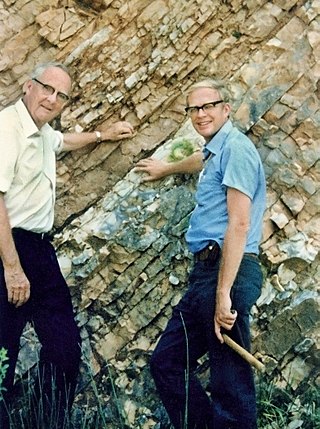
The Alvarez hypothesis posits that the mass extinction of the non-avian dinosaurs and many other living things during the Cretaceous–Paleogene extinction event was caused by the impact of a large asteroid on the Earth. Prior to 2013, it was commonly cited as having happened about 65 million years ago, but Renne and colleagues (2013) gave an updated value of 66 million years. Evidence indicates that the asteroid fell in the Yucatán Peninsula, at Chicxulub, Mexico. The hypothesis is named after the father-and-son team of scientists Luis and Walter Alvarez, who first suggested it in 1980. Shortly afterwards, and independently, the same was suggested by Dutch paleontologist Jan Smit.
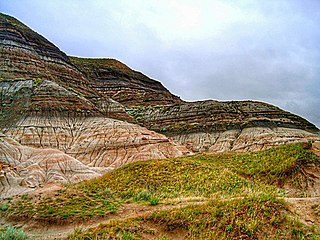
The Cretaceous–Paleogene (K–Pg) boundary, formerly known as the Cretaceous–Tertiary (K–T) boundary, is a geological signature, usually a thin band of rock containing much more iridium than other bands. The K–Pg boundary marks the end of the Cretaceous Period, the last period of the Mesozoic Era, and marks the beginning of the Paleogene Period, the first period of the Cenozoic Era. Its age is usually estimated at 66 million years, with radiometric dating yielding a more precise age of 66.043 ± 0.043 Ma.
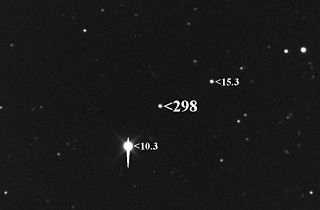
The Baptistina family is an asteroid family of more than 2500 members that was probably produced by the breakup of an asteroid 170 km (110 mi) across 80 million years ago following an impact with a smaller body. The two largest presumed remnants of the parent asteroid are main-belt asteroids 298 Baptistina and 1696 Nurmela. The Baptistina family is part of the larger Flora clan. It was briefly speculated that the Chicxulub impactor was part of the Baptistina family of asteroids, but this was disproven in 2011 using data from the Wide-field Infrared Survey Explorer (WISE).
The East Warburton Basin in South Australia is the site of a hypothesised large impact crater of the Carboniferous period. The subterranean structure lies buried at a depth of ~4 km, and measures a minimum of 200 km in diameter. For comparison, the Chicxulub crater, which caused the Cretaceous–Paleogene extinction event, is about 180 km in diameter. The East Warburton crater is adjacent to the West Warburton crater, which is also around 200 km in diameter. Combined, they make up the largest known impact zone on Earth, but individually, are smaller than the largest in the world, the 300 km wide Vredefort impact structure in South Africa. The Warburton craters formed when an asteroid or comet, on a collision course with Earth, split into two main pieces and impacted the Australian continent, then part of the Gondwanan supercontinent.

Adriana C. Ocampo Uria is a Colombian planetary geologist and a Science Program Manager at NASA Headquarters. In 1970, Ocampo emigrated to California and completed her Master in Sciences at California State University, Northridge and finished her PhD at the Vrije Universiteit in the Netherlands. During high school and graduate studies she worked at the Jet Propulsion Laboratory, where she serves as the science coordinator for many planetary missions.

The Cretaceous–Paleogene (K–Pg) extinction event, also known as the K–T extinction, was the mass extinction of three-quarters of the plant and animal species on Earth approximately 66 million years ago. The event caused the extinction of all non-avian dinosaurs. Most other tetrapods weighing more than 25 kg (55 lb) also became extinct, with the exception of some ectothermic species such as sea turtles and crocodilians. It marked the end of the Cretaceous period, and with it the Mesozoic era, while heralding the beginning of the current era, the Cenozoic. In the geologic record, the K–Pg event is marked by a thin layer of sediment called the K–Pg boundary, Fatkito boundary or K–T boundary, which can be found throughout the world in marine and terrestrial rocks. The boundary clay shows unusually high levels of the metal iridium, which is more common in asteroids than in the Earth's crust.

Since the 19th century, a significant amount of research has been conducted on the Cretaceous–Paleogene extinction event, the mass extinction that ended the dinosaur-dominated Mesozoic Era and set the stage for the Age of Mammals, or Cenozoic Era. A chronology of this research is presented here.
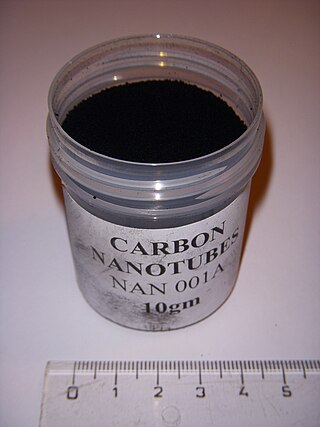
Techniques have been developed to produce carbon nanotubes (CNTs) in sizable quantities, including arc discharge, laser ablation, high-pressure carbon monoxide disproportionation, and chemical vapor deposition (CVD). Most of these processes take place in a vacuum or with process gases. CVD growth of CNTs can occur in a vacuum or at atmospheric pressure. Large quantities of nanotubes can be synthesized by these methods; advances in catalysis and continuous growth are making CNTs more commercially viable.
Alan Russell Hildebrand is a Canadian planetary scientist and Associate Professor in the Department of Geoscience at the University of Calgary. He has specialized in the study of asteroid impact cratering, fireballs and meteorite recovery. His work has shed light on the extinction event caused by the Chicxulub asteroid at the end of the Cretaceous period. Hildebrand is one of the leaders of the Prairie Meteorite Network search project.
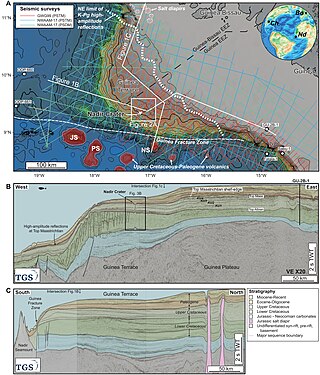
Nadir crater is a buried impact crater on the Guinea Plateau in the Atlantic Ocean, 400 kilometres off the coast of Guinea. The feature is named after the Nadir Seamount, located 100 km to the south. The paper announcing the discovery of the feature was published in Science Advances in 2022, with an impact origin being confirmed in 2024. The crater is around 9.2 km (5.7 mi) in diameter, and formed around 66 million years ago, close to the Cretaceous–Paleogene boundary when a small asteroid struck the ocean floor.

Chicxulub Puerto is a small coastal town in Progreso Municipality in the Mexican state of Yucatán. It is located on the Gulf of Mexico, in the northwestern region of the state about 8 km east of the city port of Progreso, the municipality seat, and 42 km north of the city of Mérida, the state capital. According to the INEGI census conducted in 2020, the port town had a population of 7,591 inhabitants.
References
- ↑ "1991: Sharman becomes first Briton in space". BBC News. 1991-05-18. Archived from the original on 2008-03-07. Retrieved 2008-02-01.
- ↑ Balbus, Steven A.; Hawley, John F. (1991). "A powerful local shear instability in weakly magnetized disks". The Astrophysical Journal . 376: 214–233. Bibcode:1991ApJ...376..214B. doi:10.1086/170270.
- ↑ Iijima, Sumio (7 November 1991). "Helical microtubules of graphitic carbon". Nature . 354 (6348): 56–58. Bibcode:1991Natur.354...56I. doi:10.1038/354056a0. S2CID 4302490.
- ↑ Monthioux, Marc; Kuznetsov, Vladimir L. (2006). "Who should be given the credit for the discovery of carbon nanotubes?" (PDF). Carbon. 44 (9): 1621. Bibcode:2006Carbo..44.1621M. doi:10.1016/j.carbon.2006.03.019 . Retrieved 2012-02-03.
- ↑ Zimmermann, Philip (2001-06-05). "PGP Marks 10th Anniversary". Archived from the original on 2011-05-14. Retrieved 2012-01-28.
- ↑ "Welcome to info.cern.ch, the website of the world's first-ever web server". CERN. Archived from the original on 27 May 2008. Retrieved 25 May 2008.
- ↑ "World Wide Web—Archive of world's first website". World Wide Web Consortium. Retrieved 25 May 2008.
- ↑ "World Wide Web—First mentioned on USENET". 6 August 1991. Archived from the original on 12 May 2008. Retrieved 25 May 2008.
- ↑ "The original post to alt.hypertalk describing the WorldWideWeb Project". Google Groups . 9 August 1991. Retrieved 25 May 2008.
- ↑ Pope, Kevin O.; et al. (9 May 1991). "Mexican site for K/T impact crater?". Nature . 351 (6322): 105. Bibcode:1991Natur.351..105P. doi: 10.1038/351105a0 . S2CID 36707836.
- ↑ Hildebrand, Alan R.; Penfield, Glen T.; Kring, David A.; Pilkington, Mark; Zanoguera, Antonio Camargo; Jacobsen, Stein B.; Boynton, William V. (September 1991). "Chicxulub Crater: a possible Cretaceous/Tertiary Boundary impact crater on the Yucatán Peninsula, Mexico". Geology . 19 (9): 867–871. Bibcode:1991Geo....19..867H. doi:10.1130/0091-7613(1991)019<0867:CCAPCT>2.3.CO;2.
- ↑ Schulte, Peter; et al. (2010). "The Chicxulub Asteroid Impact and Mass Extinction at the Cretaceous- Paleogene Boundary" (PDF). Science . 327 (5970): 1214–1218. Bibcode:2010Sci...327.1214S. doi:10.1126/science.1177265. PMID 20203042. S2CID 2659741.
- ↑ Candelas, Philip; de la Ossa, Xenia; Green, Paul; Parks, Linda (1991). "A pair of Calabi–Yau manifolds as an exactly soluble superconformal field theory". Nuclear Physics B . 359 (1): 21–74. Bibcode:1991NuPhB.359...21C. doi:10.1016/0550-3213(91)90292-6.
- ↑ Wang, Qiudong (1991). "The global solution of the n-body problem". Celestial Mechanics and Dynamical Astronomy . 50 (1): 73–88. Bibcode:1990CeMDA..50...73W. doi:10.1007/BF00048987. ISSN 0923-2958. S2CID 118132097.